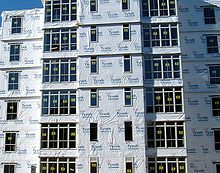Housewrap
This article needs additional citations for verification. (August 2008) |

Housewrap (or house wrap), also known by the
fiberglass or cellulose insulation will lose its R-value due to heat-conducting moisture. House wrap may also serve as an air barrier if it is sealed carefully at seams.[1]
Housewrap is a replacement for the older tar paper or asphalt saturated felt on walls. It is lighter in weight, available in much wider rolls, and both faster and easier to apply.
Major types
- Nonwoven fabric
- Micro-perforated, cross-lapped films
- Films laminated to spunbond nonwovens (Typar or CertaWrap)
- Films laminated or coated to polypropylene wovens
- Supercalendered, wetlaid polyethylene fibril nonwoven ("Tyvek")
- Drainable housewraps[clarification needed]
Installation
Housewrap is installed between the sheathing and the exterior siding, and is utilized behind vinyl, wood clapboards, shingles or shakes, brick, and other building materials. In all cases, the housewrap helps prevent water intrusion when moisture in any form gets past the siding and its trim and caulking.
As such, housewrap must be both water shedding and have a high
UV
. Some new designs must be installed carefully or they will slightly rip or tear during installation, possibly allowing for water infiltration at the damaged areas. Being both thin and inelastic, most newer designs do not "self-seal" well against nails or staples like asphalt products.
Properties
- Typical MVTR ~200 grams/100 square-inches/24hours (or greater, i.e., Tyvek is ~400)
- Typical 2 ounces/square-yard (varies greatly with manufacturer)
- Typical width 9' (108)" on a 3" core
References
- OCLC 56315804.
- ^ Reed, Ryan (May 2004). "Housewrap Felt or Paper: Comparing specs on weather barriers". BUILDERnews Magazine. Pacific NW Publishing, Inc. Archived from the original on 2004-08-20. Retrieved 2016-02-24.
